Thinking about building a chicken coop? Let’s jump right into some design features that can make your feathered friends feel right at home. From smart ventilation to cozy nesting areas, there are plenty of practical and fun elements to consider for your coop setup!
Easy Cleaning Access Points
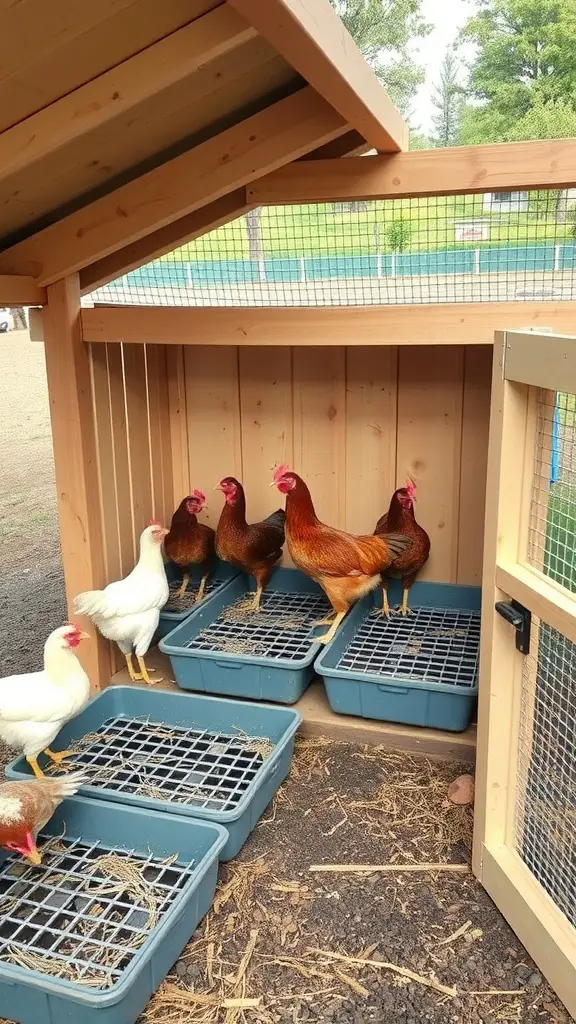
Keeping a chicken coop clean is essential for healthy chickens and a pleasant backyard. The image shows a well-designed coop with easy access points that make cleaning a breeze.
The coop features large openings and removable trays to catch waste. These trays make it simple to pull out and dispose of waste without disturbing the chickens too much. A clean coop helps prevent odors and keeps the environment healthy for your feathered friends.
With the right design, cleaning becomes less of a chore. You can focus on what really matters—enjoying your chickens and the fresh eggs they provide!
Integrated Feed and Water Stations

Integrating feed and water stations in your chicken coop can make a big difference in how your flock thrives. In the image, you can see a well-designed feed station that keeps food clean and accessible for the chickens. This setup helps reduce waste and allows for easier refilling.
Having a designated area for feeding and watering encourages chickens to eat and drink more regularly. The design shown here is user-friendly, making it simple for owners to maintain. A clean feed and water station means healthier chickens and less hassle for you!
Remember, the easier it is for your chickens to access their food and water, the happier they’ll be. Plus, a clean environment helps prevent common issues like pests or mold, making your coop a safer space.
Temperature Regulation Mechanisms
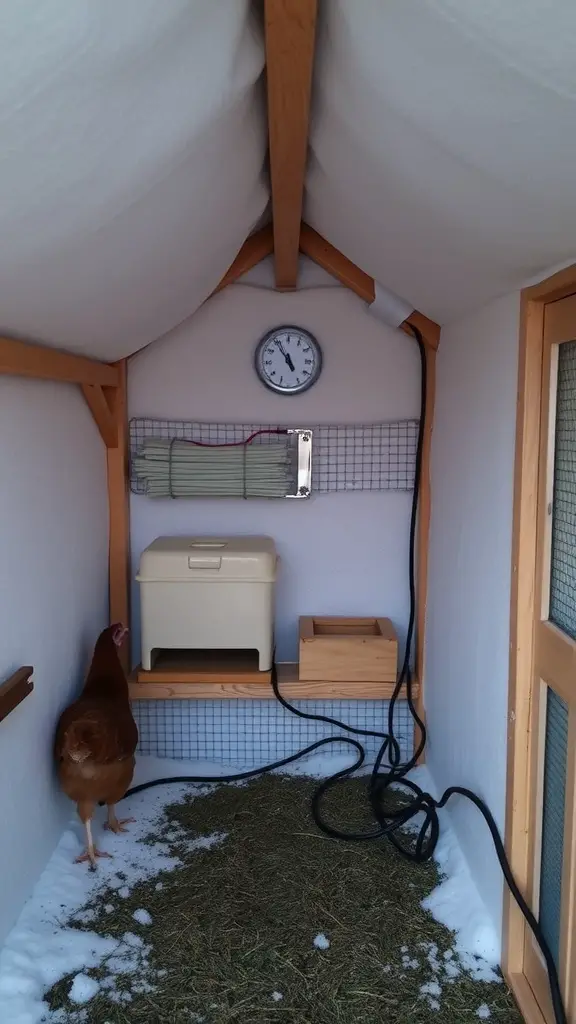
When it comes to chicken coop design, temperature regulation is key. A cozy environment keeps your chickens happy and healthy. In the image, you can spot a well-insulated coop with a few essential features.
Notice the clock on the wall. Keeping track of time helps you monitor daily activities, including checking on temperature settings. The insulation plays a big role as it retains heat during colder months. This design helps chickens stay warm and comfortable.
There’s also a heater system visible in the image. This ensures that even during the chilly seasons, your feathered friends have a warm space. The setup includes wires that connect to the heating element, showing that technology can assist in maintaining the perfect climate.
The clutter-free area allows for easy movement and cleaning, which is important for maintaining hygiene. Healthy chickens lead to better egg production! The natural elements, like the straw on the floor, also help with insulation and comfort.
Secure Predation Prevention Features

When it comes to chicken coops, security is a top priority. The image shows a sturdy coop with a mesh wire design. This type of wire is perfect for keeping out predators while allowing airflow.
The secure latch on the door is another key feature. It prevents any unwanted visitors from getting inside. Chickens can roam safely, knowing that their home is well-protected.
Additionally, the coop’s height can help deter certain animals. Elevating the structure makes it harder for larger predators to reach the chickens. A well-thought-out coop layout ensures that your feathered friends stay safe and sound.
Outdoor Run Connection for Free Range
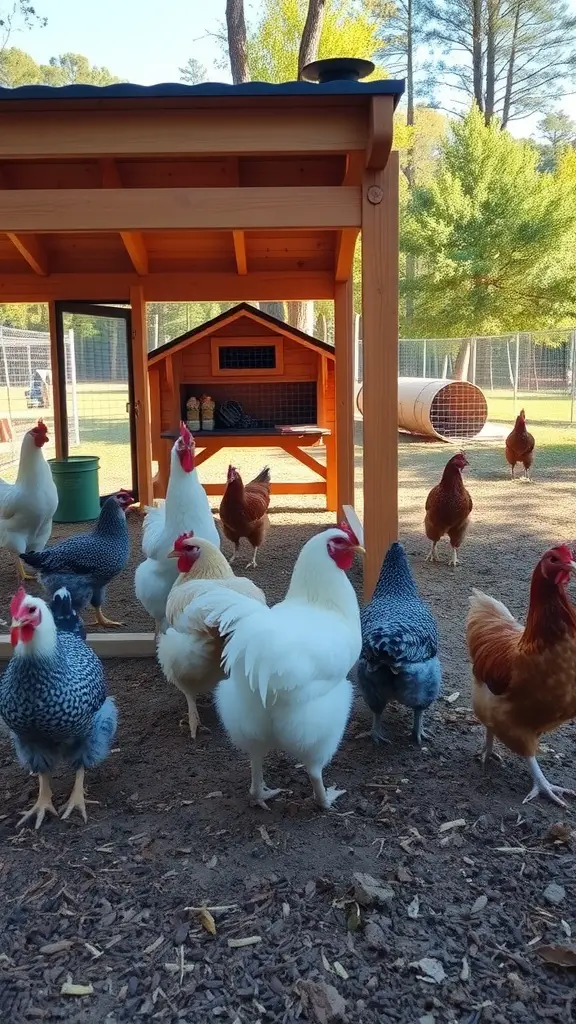
Having an outdoor run connected to the chicken coop is a fantastic feature for any chicken keeper. It allows the birds to enjoy fresh air and sunshine while remaining safe from predators. The image shows a lovely setup where chickens roam freely in a spacious run.
The design of the run is crucial. It should be sturdy, with tall fencing to prevent any unwanted visitors. The coop in the background looks cozy and inviting, providing shelter for the chickens when they need a break. This blend of safety and freedom is ideal for happy, healthy birds.
Adding natural elements like plants or dust baths in the outdoor run can enhance the chickens’ experience. They love to peck at grass and explore, which keeps them engaged. With a well-planned outdoor space, your chickens can thrive while enjoying the great outdoors.
Ventilation Systems for Fresh Air
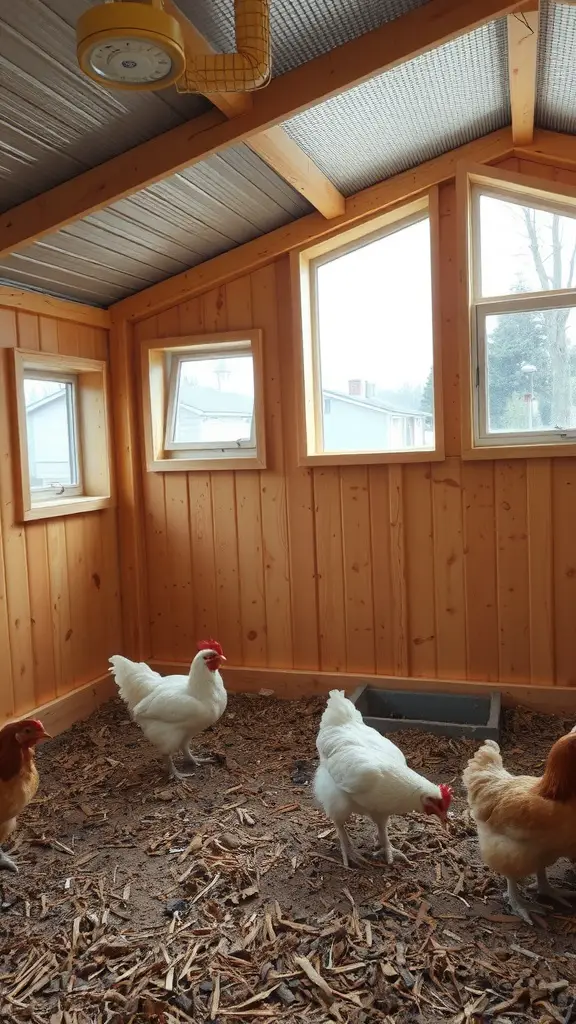
Good ventilation is key in a chicken coop. It keeps the air fresh and prevents the buildup of harmful gases like ammonia.
The image shows a well-designed coop with multiple windows and a ventilation fan. These features work together to maintain airflow, ensuring that your chickens stay healthy and comfortable.
Windows allow for natural ventilation. When opened, they let in fresh air while letting out stale air. This is essential, especially on warm days, as it helps to regulate the temperature inside the coop.
The fan, attached to the ceiling, boosts air circulation. It’s particularly useful during hot weather. A good airflow helps reduce humidity, which can lead to respiratory issues in chickens.
Creating a balance between natural and mechanical ventilation is important. Too much airflow can be just as harmful as too little. Observing your chickens can guide you. If they seem lethargic or huddled, the airflow may need adjusting.
Roosting Bars for Natural Sleeping
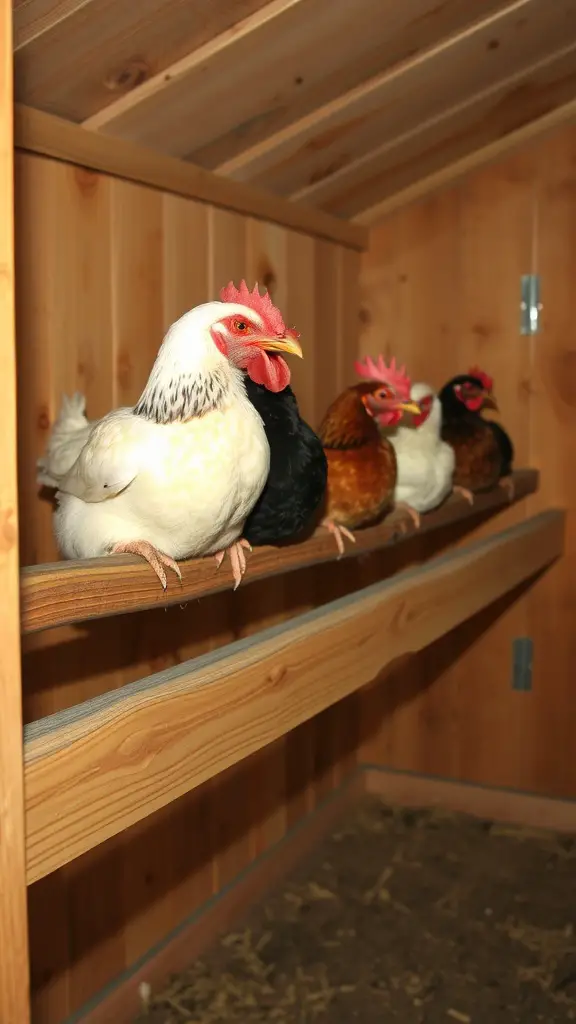
Roosting bars are essential features in any chicken coop design, allowing chickens to sleep comfortably off the ground. In the image, we see several chickens resting on a sturdy, well-placed roosting bar. This setup mimics their natural habitat, where they would choose higher perches to feel safe from predators.
The height of the roosting bars can vary based on the size of the coop and the breeds of chickens. Ideally, these bars should be about two to three feet off the ground. This gives the birds a sense of security while providing ample space for all of them to find their spot.
Using smooth, rounded wood for the roosting bars is a smart choice. It helps prevent injuries to the chickens’ feet, allowing them to grip comfortably while they sleep. The image shows a clean, simple design that promotes natural behavior, encouraging the hens to settle in for the night.
Having multiple bars at different heights can also benefit the pecking order among your flock. Some birds may prefer a higher perch, while others might feel more secure lower down. This flexibility can help reduce stress and create a peaceful sleeping environment.
Nesting Boxes Optimized for Comfort
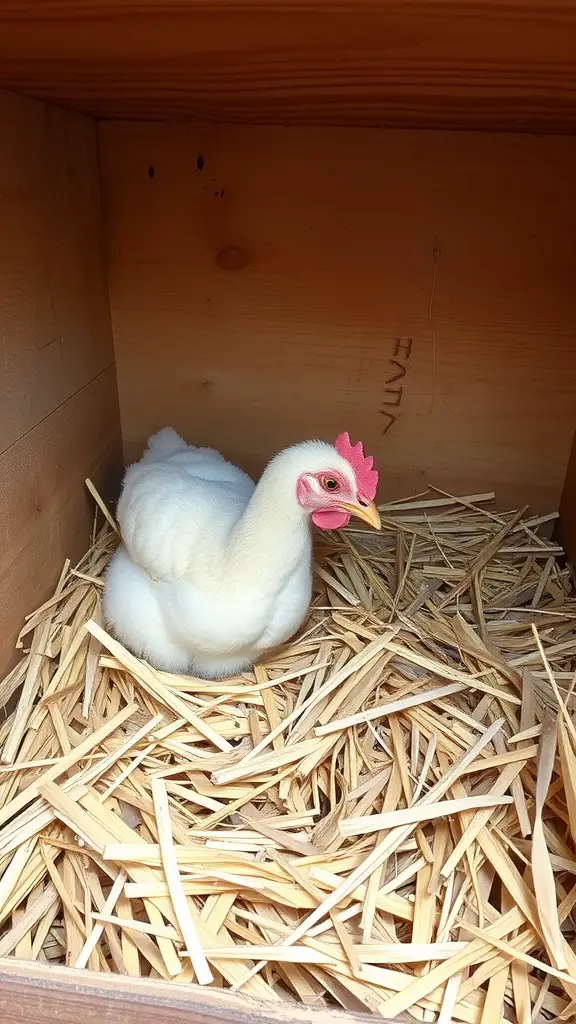
Nesting boxes are a key feature in any chicken coop. They provide a safe and cozy space for hens to lay their eggs. A well-designed nesting box is not just about looks; it’s about comfort. In our image, you can see a hen comfortably settled in a nesting box lined with straw. This setup helps create a warm and inviting environment.
Choosing the right materials is important. Straw is a popular choice for bedding because it’s soft and easily replaced. The hen in the image looks relaxed, showing how essential comfort is for laying eggs. Make sure the boxes are spacious enough for the hens to move around without feeling cramped.
Placement also matters. Nesting boxes should be placed in a quiet corner of the coop, away from the hustle and bustle. This gives hens the peace they need when laying eggs. Proper ventilation is crucial too, ensuring the boxes remain fresh.
Overall, optimizing nesting boxes for comfort can lead to happier hens and better egg production. Happy hens mean more eggs for you!
Lighting Solutions for Egg Production
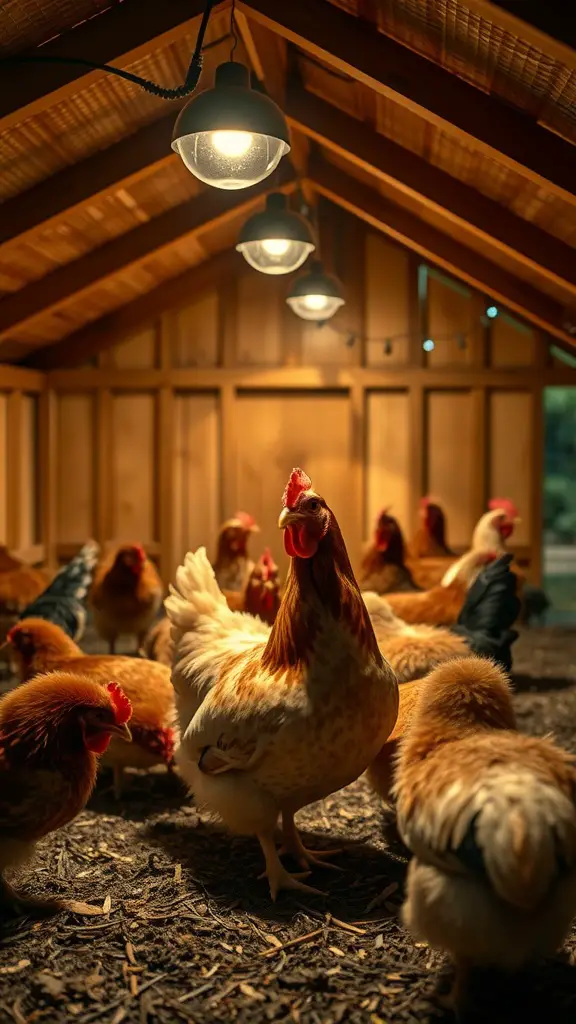
Lighting plays a big role in egg production inside a chicken coop. In the image, you see a well-lit coop that helps create a comfortable environment for the hens. The light not only brightens up the space but also encourages the hens to lay more eggs.
Chickens need about 14 to 16 hours of light each day to stay productive. Using artificial light can help achieve this during shorter days. The coop in the picture has a light fixture that illuminates the area without being too harsh. This helps the hens feel secure while promoting their laying cycle.
Choosing the right type of lighting is also important. LED lights are energy-efficient and provide a steady light source. They can be placed strategically to avoid shadows, which can stress the birds. With the right lighting, your hens will thrive and produce more eggs.
Space Optimization for Chicken Welfare
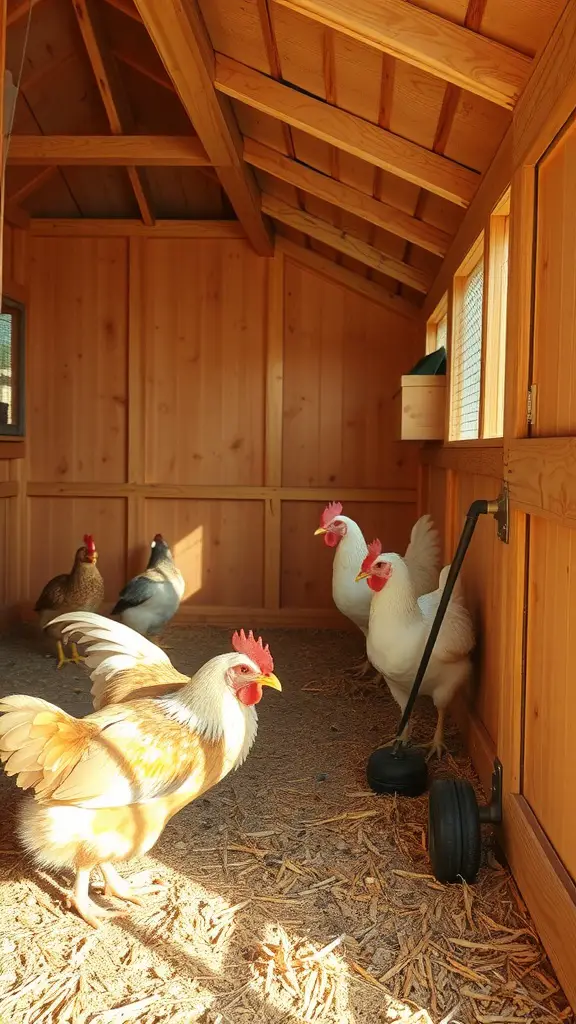
Creating a comfortable space for chickens goes beyond just providing shelter. In the image, we see a well-designed coop that prioritizes the wellbeing of its feathered inhabitants. The wooden structure offers ample headroom, allowing chickens to move freely without feeling cramped.
The use of natural materials like wood not only looks nice but also helps regulate temperature and humidity inside the coop. Proper ventilation is key too, as seen in the coop’s windows, allowing fresh air to circulate while keeping drafts out.
In a well-optimized space, chickens can express their natural behaviors. The layout seen here provides room for movement and exploration, fostering a happier and healthier flock. Nesting boxes are neatly integrated, making it easy for hens to lay eggs in a calm environment. Overall, this design shows that with thoughtful planning, we can create a space that meets the needs of our chickens.
Customized Coop Layouts for Different Breeds
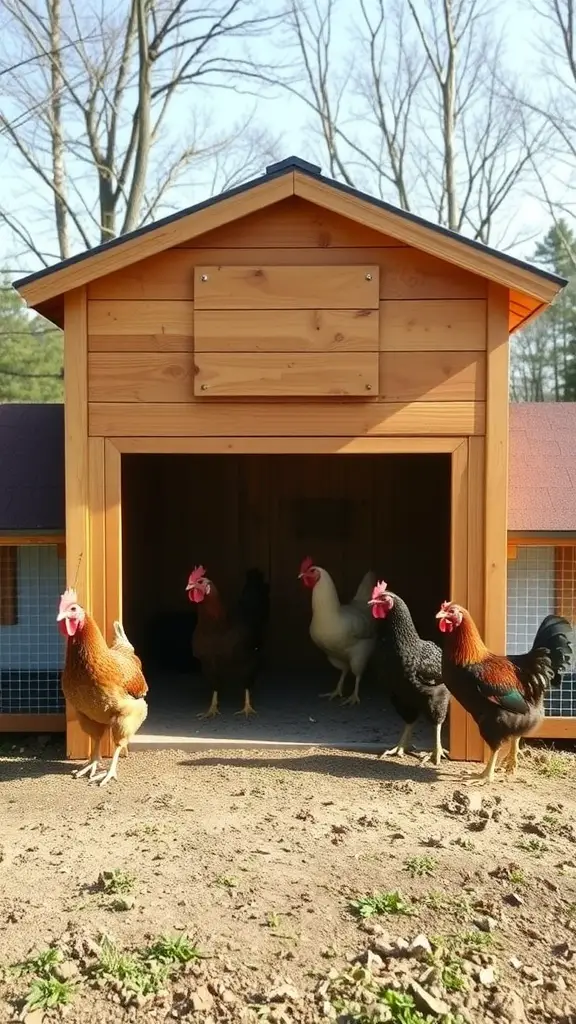
When it comes to chicken coops, one size definitely does not fit all. Different breeds have unique needs that can influence the coop’s layout. In this image, we see a cozy coop that showcases a solid structure and an inviting entrance, perfect for various chickens.
The design allows easy access for the birds, with a wide door that encourages them to venture in and out comfortably. While the layout is spacious, it’s essential to tailor it further based on the specific breed. For instance, larger breeds like Jersey Giants need more room, while smaller ones can thrive in a more compact space.
Ventilation and sunlight also play a significant role in the health of your chickens. Coops should have windows or openings to ensure fresh air circulates inside. The coop in the image seems well-placed to capture sunlight, which benefits the birds, especially during colder months.
Finally, consider the ground space outside the coop. Chickens love to roam and scratch around. The area surrounding the coop can be designed to offer plenty of activities for your feathered friends. This setup not only makes them happy but also keeps them healthy.


